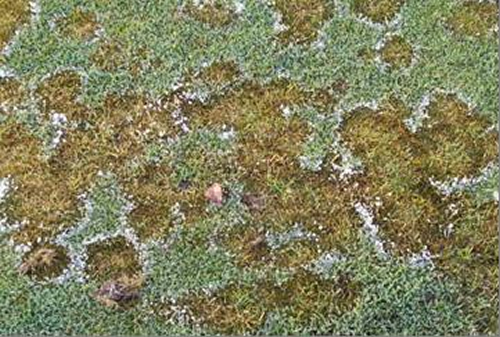Fusarium
Create a lawn to love ...
a space to make memories
Fusarium
Fusarium is a common lawn fungal disease predominantly found during cool wet conditions typically autumn and winter.
FUSARIUM OVERVIEW
Fusarium patch, also called snow mould, is a common cause of brown patches on lawns, particularly in autumn or during mild spells in winter. It is often seen on fine fescue lawns, but can develop on all lawn types.
Because it strikes at times the lawn is not actively growing we think it's one of the most visually damaging diseases because recovery can be slow leaving scaring visible for long periods of the winter period.

What turf does it affect?
It can be observed all year round on all types of turf.
What causes Fusarium Patch Disease to develop?
The disease will not kill rhizomatous turf.
Fusarium Patch Disease is caused by mild autumnal or winter weather.
Conditions that assist its development are:
- Lower light levels due to cloud cover
- Reduced daylight hours
- Morning mists that are slow to clear
- Lack of air movement
- Overnight temperatures remaining above seasonal averages.
Fusarium fungus (Microdochium (Fusarium) Nivale) is a naturally occurring turf fungus well known by turf professionals. The fungal spores exist within the body of virtually all turf at all times. When climatic conditions are suitable the spores can become very active and result in the development of visible brown patches and mould.
Control Treatments
Fusarium is a disease that has been caused by nature and the best remedy is also provided by nature. A change in weather conditions to colder temperatures, higher light levels and greater air movement usually corrects the problem. It is necessary for these conditions to then prevail to prevent the condition from returning.
How can I control fusarium?
Non-chemical control
Ensure that the lawn dries rapidly after morning dew or rainfall by improving the aeration and drainage will all help:
- Improve general airflow over the lawn by pruning back overhanging trees or shrubs;
- Remove heavy dews in the morning with a switch (a long, pliable rod) or bamboo cane;
- Scarifying, spiking and hollow- or solid tinning will all help with ongoing control;
- Increasing the soils natural biology will help build up ongoing resistance - see soil beneficial.
Our Soil Biology Booster treatment will help with building up the plants natural ability to withstand and recover from infections plus dont forget to review the abiotic reasons above.
Chemical control
In recent years fungicide was available to professional users to deal with the problem. These work by kiling the fungi and then protect against re infection. However, these products have been reformulated and now give a much shorter preventative period. If you want to treat yourself, we would suggest using a product called Bayer Lawn Disease control.
Please remember that, similar to taking antibiotics, after you have applied a fungicide, it is it doesn’t guarantee you never get the symptoms again
The pathogens remain in the soil, your lawn may require an annual fungicide application programme.
What treatments can be used?
Dependent on the time of year an application of fertiliser would promote lawn growth, affected grasses would then be removed by cutting. The feed will also strengthen the plant, enabling it to “outgrow” the disease. We also recommend Biology Booster and Soil Improver to improve soil conditions and the grass plants natural health.
Can anything be done now?
Weather permitting the promoting of new growth with fertiliser will help, you then cut out the active fungal growth. We would suggest to check to see if you’re looking at the primary effect white speckles or the secondary effect of the brown grasses, affected grasses will not revert to green, until new grass growth occurs.
Best Practice?
When looking at treating disease, you should always consider before applying chemicals what cultural and biological improvements can be used first.
The process of completing two actions dramatically increases your chance of success eg soil development with aeration would be better than just aeration.
Choosing your Grass Seed
Our proven Grass Seed Selection consists of the following Green Velvet blends:
- The All Rounder - Multi-Purpose (more resistant to fungal diseases)
- The Perfectionist - Luxury (susceptible to fungal diseases)
Coverage available 15m2, 50m2, 500m2 & 800m2
All of the above grass seed is available from our shop:
Get In Touch!
0115 837 8439
Expert lawncare with experienced personnel
Nottingham Most Reviewed lawn care
BASIS Lawn Assured
Experienced lawn care
Hard surfaces - Drives and Patios
Call for an online quote
